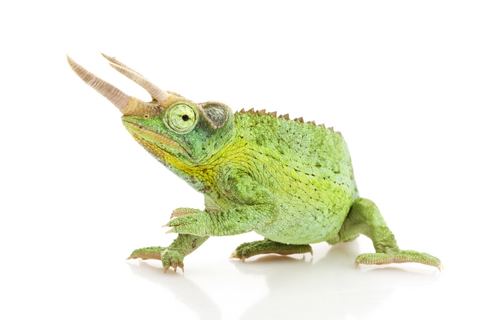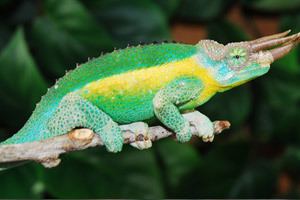Infraorder Iguania Rank Species | Phylum Chordata Suborder Lacertilia Family Chamaeleonidae | |
 | ||
Lifespan 5 – 10 years (In captivity) Lower classifications Chamaeleo jacksonii jacksonii, Dwarf Jackson's Chameleon, Yellow-crested Jackson's Chameleon Length Female: 25 – 33 cm (Adult), Male: 23 – 33 cm (Adult) | ||
Jackson's chameleon, Jackson's horned chameleon, or Kikuyu three-horned chameleon (Trioceros jacksonii ) is a species of chameleon (family Chamaeleonidae) native to East Africa, but also introduced to Hawaii and Florida.
Contents
- Sub adult jackson s chameleons
- Taxonomy
- Etymology
- Subspecies
- Habitat and geographic range
- Description
- Feeding habits
- Invasive species
- Territoriality
- Reproduction
- In captivity
- References
Sub adult jackson s chameleons
Taxonomy
Jackson's chameleon was described by Belgian-British zoologist George Albert Boulenger in 1896.
Etymology

The generic name, Trioceros, is derived from the Greek τρί- (tri-) meaning "three" and κέρας (kéras) meaning "horns". This is in reference to the three horns found on the heads of males.

The specific name, jacksonii, is a Latinized form of English explorer and ornithologist Frederick John Jackson's last name, who was serving as the first Governor of Kenya at the time.

The English word chameleon (also chamaeleon) derives from Latin chamaeleō, a borrowing of the Ancient Greek χαμαιλέων (khamailéōn), a compound of χαμαί (khamaí) "on the ground" and λέων (léōn) "lion". The Greek word is a calque translating the Akkadian nēš qaqqari, "ground lion".
Subspecies
The three subspecies, including the nominate, are:

Habitat and geographic range

Jackson's chameleons are native to woodlands and forests at altitudes of 1,600 to 2,440 m (5,250 to 8,010 ft) in south-central Kenya and northern Tanzania. In these areas, the rainfall is seasonal but exceeds 127 cm (50 in) per year. Day temperatures are typically 16–27 °C (61–81 °F), and night temperatures are typically 4–18 °C (39–64 °F). In Tanzania, it is only known from Mount Meru in the Arusha Region, which is the home of the relatively small endemic subspecies T. j. merumontanus. Jackson's chameleon is more widespread in Kenya, where it is even found in wooded areas of some Nairobi suburbs. The subspecies T. j. xantholophus (native to the Mount Kenya region) was introduced to Hawaii in 1972 and has since established populations on all main islands and became invasive species there. This subspecies has also been introduced to Florida. In Hawaii, they are mainly found at altitudes of 100 to 1,000 m (330 to 3,280 ft) in wet, shady places. Historically this population was the primary source of Jackson's chameleons for the exotic pet trade in the United States, but exports from Hawaii are now illegal. This has been done to prevent opportunists from willfully establishing further feral animal populations to capture and sell them.
Description
Jackson's chameleons are sometimes called three-horned chameleons because males possess three brown horns: one on the nose (the rostral horn) and one above each superior orbital ridge above the eyes (preocular horns), somewhat reminiscent of the ceratopsid dinosaur genus Triceratops. The females generally have no horns, or traces of the rostral horn (in the subspecies T. j. jacksonii and T. j. merumontanus). The coloring is usually bright green, with some individual animals having traces of blue and yellow, but like all chameleons, they change color quickly depending on mood, health, and temperature.
These are small to medium-sized chameleons. Adult males reach up to 38 cm (15 in) and females up to 25 cm (10 in), but more typical lengths are 15 to 25 cm (6 to 10 in). They have a saw-tooth shaped dorsal ridge and no gular crest. They attain sexual maturity after five months. The lifespan is variable, with males generally living longer than females.
Feeding habits
Jackson's chameleons live primarily on a diet of small insects. They also prey on centipedes, isopods, millipedes, spiders, lizards, small birds, and snails in their native habitat.
Invasive species
There is a threat of devastating impact of introduced invasive Jackson's chameleons to native ecosystems in Hawaii. There were found mainly insect in their stomachs: planthoppers Oliarus, grasshoppers Banza, casebearing caterpillars Hyposmocoma, beetles Oodemas, dragonflies Pantala and others. Holland et al. (2010) proved that they also prey on snails in Hawaii. Their prey include land snails Achatinella, Auriculella, Lamellidea, Philonesia, Oxychilus alliarius. They are swallowing whole snails (including shells). Jackson's chameleons introduced to Hawaii are substantial threat to native biodiversity of invertebrates and serious threat especially to endemic species, such as critically endangered O'ahu tree snails (genus Achatinella).
Territoriality
T. jacksonii are less territorial than most species of chameleons. Males will generally assert dominance over each other through color displays and posturing in an attempt to secure mating rights, but usually not to the point of physical fights.
Reproduction
Most chameleons are oviparous, but Jackson's chameleon gives birth to live offspring; eight to thirty live young are born after a five- to six-month gestation. The subspecies T. j. merumontanus gives birth to five to ten live young.
In captivity
In captivity, Jackson's chameleons require high humidity, and are in general very needy of colder temperatures during the night. Too much heat, or excessive humidity, can cause eye infections and upper respiratory infections in these animals. In captivity, the Jackson's chameleon can be expected to live between five and ten years.
